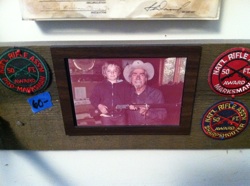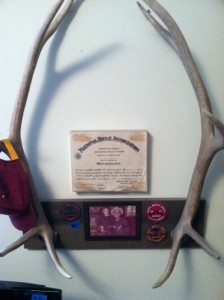Suits, skulls, knives, ivory. Life magazines, hobo biographies, wife-swapping novels, cookbooks. 50s pinups, maps, Ansel Adams’ originals, a 3-D image of Mao Tse Tung. Never used food processors, broken record players, balls and bats and backgammon sets.
What do all of these have in common? They’ve all been found at estate sales, man.
Every weekend, my wife and I pile into the Honda and drive all over the Twin Cities, classified ads in hand, looking for estate sales. Being a teacher and an underemployed novelist means that we don’t have tons of money, so estate sales help us buy things–like a new Kitchen Aid food processor–for at least a fifth of their value. As I look around my house, I notice that many of the things I own–from the books on the shelves to the fancy plates to the clothes on my back–are from estate sales. Yes, that means I’m probably wearing the clothes of the dead.
This column, which I plan to run every Sunday (depending on my ambition that week), is going to share what Janice and I found, and tell some of the stories that we see each and every week in the homes around town. You’ll see some of the crazy bargains we’ve unearthed, and some of the weird shit we left behind. This is not going to be the print version of Pawn Stars or Antiques Roadshow. Janice and I seek utility and fun, and we’re not looking for a financial bonanza.
Don’t forget, when you shop at an estate sale, you’re going through the life’s possessions of some fellow human being, someone who has retired and seeks a smaller place, or someone who has recently died. The people who run them are crackpots. The people who shop at them are crackpots. As you may know, I love crackpots, and where there’s crackpots, there’s almost always a story.
But first, please allow me to school you on some of the various types of estate sales, as well as some rules for what to do, and what not to do.
THE FOUR TYPES OF ESTATE SALES
My good friend Barry once summed up the difference between estate sales and garage sales: at garage sales, people are selling shit that they don’t want. Estate sales are, by their nature, more expensive. That’s because there’s overhead, employees, and, as noted, because there’s stuff people actually want.
If you’re going to head out looking for estate sales, grab the Friday classifieds from the Star-Tribune or Pioneer Press. I like to prepare in advance, planning my route, especially since the ads don’t give you directions. The ads often have clues as to what to expect, the sellers highlighting certain antiques, or defining the type of sale. Essentially, there’s four different types:
Digger’s Sale. A “digger’s” sale means that the person in question was very nearly a hoarder. These are often older homes, often in the city of Minneapolis or St. Paul (though they can be anywhere.) The people who run the sales probably first saw the place in a state of near ruin–don’t forget, the people who are leaving their possessions behind are usually very elderly and couldn’t organize as well as someone younger. They call these “digger” sales because you literally have to dig through piles and piles of stuff. The company running the sale can only do so much, and what they often do is, say, pile all the linens on one bed, or throw books on tables (with boxes of paperbacks underneath.) Garages are chock full of junk, even books and clothes. Basements have something in every corner, and there’s attics where someone tall like myself has to duck and dodge.
These sales are a lot of fun. They’re good places to find old books, Life magazines (I can’t get enough of these), antiques if that’s your bag, and more. Your hands will get grubby, and I seriously recommend you are up-to-date on your tetanus shots. I’ve been jabbed by any number of rusty staples while digging through old magazines, not to mention nails and screws from shelves and floorboards.
Clean, or Shoes Off Sales. One thing I’ve discovered estate sale-ing is that you can never tell what you’ll find, even in the most pristine homes. It used to be I thought suburban homes would suck–I would never live there, what can they possibly have that I would want? Plenty as it turns out. The “clean” or “shoes off” sales are high-end homes, often in the ‘burbs or the wealthiest part of the cities (by the lakes, etc.) These folks face a similar situation–death, downsizing–but they’ve tossed much of their stuff during their lives. “Shoes off” means that you have to remove your shoes before entering, since they have nice, white carpets. This is a bitch when it’s raining or in the winter, as your socks inevitably get damn wet even on the short walk to the front door.
But clean sales are where you can find awesome clothing, designer material, suits, etc. This is typically where you get your great kitchen appliances, tools, etc. If I had to hazard a guess, the Kitchen Aid food processor we found was probably a gift, given to the wealthy grandma by the wealthy daughter-in-law (or something like that), and she died soon after. Book-wise, this is the land of crappy old bestsellers. Looking for a hardcover copy of The DaVinci Code? Clean sales are where you’ll find it.
The In-Between. In between the clean and digger’s sales are sales that aren’t quite diggers, aren’t quite clean. Often you see sales run by churches, and these guys are super-friendly, but they don’t usually have great stuff in them. They’re not professional retailers (many of the people who work for estate sale companies have antique shops on the side) and so when a member of that church passes on, they help out for a minimal fee. You find some good stuff there–they’re certainly worth checking out–and the people haggle more easily. You rarely, if ever, find really, really cool items at the church sales. (That could also be because I don’t get to these right when they open.)
Some companies combine smaller estates together and sell their items in a warehouse, or the person hiring them doesn’t want a bunch of strangers poking around in the house for various reasons. Birkeland and Associates has a warehouse sale nearly every weekend, and other companies sometimes rely on this now and again. It’s not as interesting to me, since seeing the person’s home is always fascinating. But you can still find good stuff at these.
The Garage Sale Posing as an Estate Sale. You can always tell a fake estate sale because they typically are not associated with a company (each company has its name in the classified ad, or a webpage.) The descriptions are poor. These are just garage sales, folks, that someone chose to do in the winter or got the bright idea to fool you into coming by advertising it as an estate sale. Run away–these things suck.
THIS WEEK’S SALES
This weekend was the first of the new year for estate sale-ing. For whatever reason, most of the big companies didn’t have sales–there was one in Edina, and three on the other side of the river: one each in Inver Grove Heights, Eagan, and St. Paul. And yes, there was one of those fake fuckers in Minneapolis that we avoided.
A flu bug kept me from two of the sales, but we did hit Eagan and Edina.
EAGAN: CLEAN, AND ALMOST WORTHLESS. Ugh. This sale, on Dawn Avenue, was totally devoid of atmosphere. Sometimes the clean sales feature the worst of suburban living. I seriously don’t see how people can live by eating, reading, and watching the most mediocre shit the world pumps out. The art could be hanging in a McDonald’s, the books are bland titles of no interest, the furniture drab and cheap. As I said, clean sales don’t always mean boring–there have been some totally crazy clean sales in the past, like the modern home that looked like it was from Sleeper, tucked away in the woods behind Cedar Lake. This one was dull as hell.
Its one saving grace seems to be that the people who owned it wanted it to be a fun home for their grandkids. There were tons of books (the usual kids classics–Madeline, Dr. Seuss, etc.), lots of drawing tablets and pens and such. Janice found a box full of superballs which she actually needs for science experiments. I found a Yomega Fireball yo-yo, nothing amazing (you can buy ‘em for ten bucks), but at fifty cents, it’ll do.
 EDINA: WHERE THE SHARPSHOOTERS LIVE. This one intrigued me. It was a strange split-level home, with what I would describe as having rough wood siding, painted gray (it appeared as if you’d get splinters if you ran your hand on the siding.) The inside hadn’t been updated since the 1980s, and the kitchen carpeting had worn through and was patched with duct tape long ago. A woman named Mavis lived here, and collected tons of books, and if the titles are any indication, seemed devoutly religious.
EDINA: WHERE THE SHARPSHOOTERS LIVE. This one intrigued me. It was a strange split-level home, with what I would describe as having rough wood siding, painted gray (it appeared as if you’d get splinters if you ran your hand on the siding.) The inside hadn’t been updated since the 1980s, and the kitchen carpeting had worn through and was patched with duct tape long ago. A woman named Mavis lived here, and collected tons of books, and if the titles are any indication, seemed devoutly religious.
This was an in-between sale, not quite diggers, not quite clean. As you walked in, you turned to your left and bounded up four steps to the living room where the cashier sat, as well as the valuables table. At almost every sale the company running the thing sets up a table with a glass case containing every tiny valuable item enclosed within. Jewelry, rare stamps, knives, even rare postcards and coins. Items that would be easy to steal. Here there were a few rings and coins, and a bunch of stamps, but nothing exciting.
Mavis apparently loved puzzles and games. My God, there were tons and tons of puzzles, which is frightening because that meant that soon we would own tons and tons of puzzles, since Janice can’t get enough of them. We emerged with six new puzzles, as well as a 1960s Parker Bros. word game called, intriguingly enough, “Probe”. Over a person’s lifetime, they accumulate oddities of every stripe: on the same table in the front room, among the pizza puzzles (don’t ask) was a Dennis Quaid autographed copy of the DVD Frequency. The front room also had a piano, tons of books (mostly classics and Christian reading, nothing interesting), more postcards, a mahjongg game, and a copy of a game called “Wordsworth”, with the most ridiculous cover ever.
The basement was filthy, which was a bit disappointing, since there were tons more books downstairs. That’s something to watch out for: if you smell mildew in a basement, do not buy clothes, do not buy paper products. That smell will never go away, and it will contaminate your books and clothes at home. That said, I discovered Mavis had good taste in classical music–I bought, for ten bucks, thirteen CDs, Brahms, Moussorgsky, Mozart, conducted by such luminaries as Ormandy, Marriner, von Karajan, and Bernstein, and on such labels like Philips and Deutsche Grammophon. These are nearly impossible to score from the library, so it was worth the ten-spot. (And since they’re plastic, they didn’t stink.)
 Mavis apparently loved preserving food and making wine, since there were bottles and bottles of homemade wine in boxes in the basement, and lots of canned goods. This was rare–usually you just find the supplies. But it’s illegal to sell alcohol. Not that I would have tried it, but it was sad to know her labors were headed for the trash. Mavis also made a pair of scrapbooks detailing her family’s trip to the Holy Land (Israel, not the awesome Northeast restaurant and grocery store.)
Mavis apparently loved preserving food and making wine, since there were bottles and bottles of homemade wine in boxes in the basement, and lots of canned goods. This was rare–usually you just find the supplies. But it’s illegal to sell alcohol. Not that I would have tried it, but it was sad to know her labors were headed for the trash. Mavis also made a pair of scrapbooks detailing her family’s trip to the Holy Land (Israel, not the awesome Northeast restaurant and grocery store.)
This added to the general sadness of the place, the melancholy you often feel when plundering the lifetime collections of these good people. According to her obituary, Mavis was preceded in death by both her husband and daughter. That left only a son, and who knows his whereabouts? Apparently he didn’t want even a scrapbook of a family trip, or he was out of the picture, for one reason or another.
 His name was Steve, and I know this because I ventured into Steve’s room. A little plaque still affixed to the door told me this was Steve’s place, and since the plaque was clearly from the 70s or 80s, it also told me that Mavis wanted to keep that room intact, at least to a degree.
His name was Steve, and I know this because I ventured into Steve’s room. A little plaque still affixed to the door told me this was Steve’s place, and since the plaque was clearly from the 70s or 80s, it also told me that Mavis wanted to keep that room intact, at least to a degree.
And that’s where the Shrine of the Sharpshooter was located (that’s the picture at the top.) You can see young Steve in the photo. Is that his Grandpa? Some NRA Master of the Rifle? Some singing cowboy? As you can see, he had earned a fifty-foot marksman patch (twice) and a fifty-foot sharpshooter patch (and certificate) from the NRA. The guys running the sale tried to sell the works for $60. When I went back on Sunday, when things were cheaper and you could haggle (no haggling on day one–this is a pretty hard and fast rule), the shrine was still there. Who would want it?
Apparently, no one. Just as no one wanted that beautiful hand-tinted photo of Mavis as a young woman.
Mavis left us with three Life magazines (I didn’t take the Kennedy issues, which are everywhere), an issue of U. S. Camera from 1955, The Swamp Root Almanac Dream Book from 1935, two videotapes of movies that you could get on Netflix, a baking pan, a dozen classical music CDs, Probe–A Game of Words, puzzles galore, and a bunch of large post-it notes. And a copy of the Girl with the Dragon Tattoo, since Janice was looking to read it after having seen the movie.
Thank you, Mavis.



Pete, this is great–let’s plan a Saturday morning of estate saleing and crib!